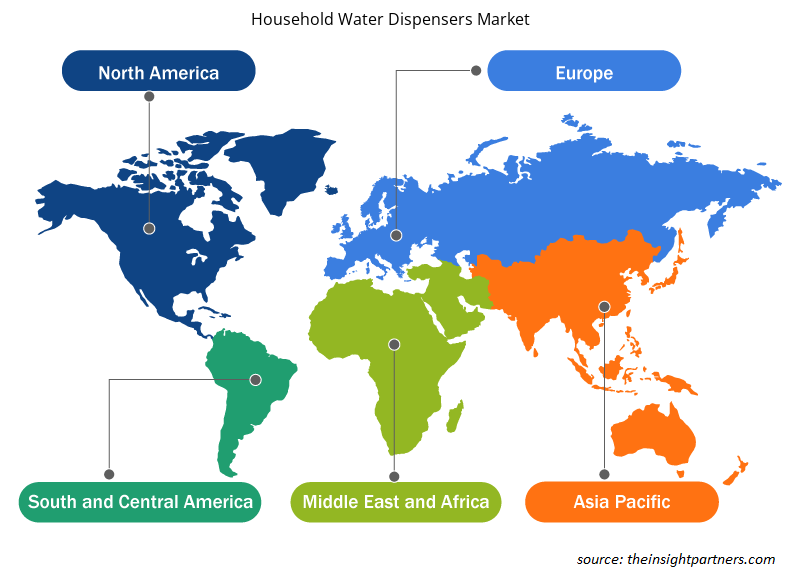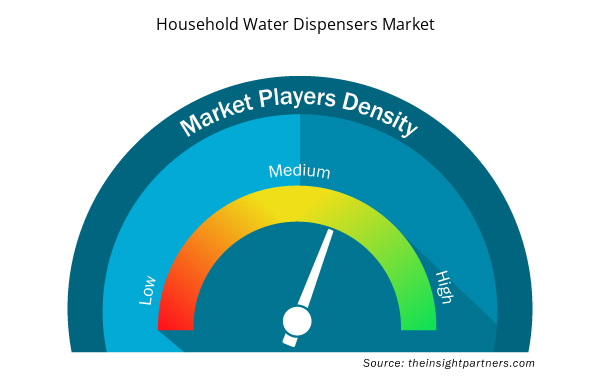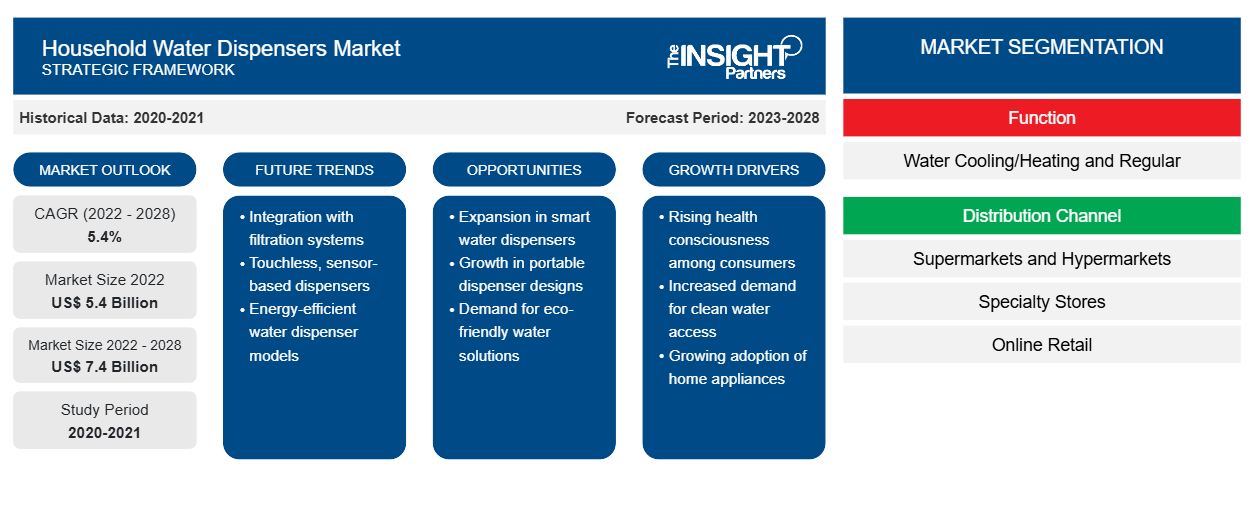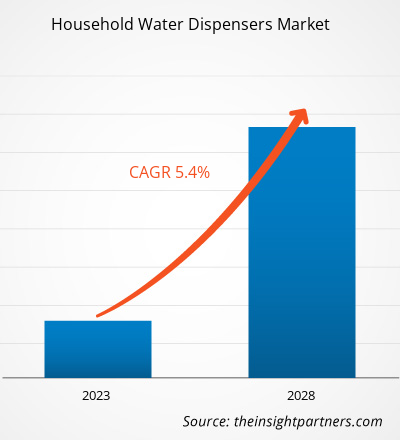[연구 보고서] 가정용 정수기 시장은 2022년에 5,395.43백만 달러 규모로 평가되었으며, 2028년까지 7,401.12백만 달러에 도달할 것으로 예상됩니다. 2022년부터 2028년까지 연평균 성장률 5.4%를 기록할 것으로 예상됩니다.
지하수 오염이 증가함에 따라 콜레라, 대장균, 위장관 질환과 같은 수인성 질병이 증가하여 가정용 정수기 수요가 증가하고 있습니다. 질병 통제 예방 센터(CDC)에 따르면 미국에서는 매년 44명 중 1명이 수인성 질병을 앓고 있습니다. 그러나 정수기는 크립토스포리디움과 지아르디아와 같은 오염 물질을 제거하여 위장관 질환 가능성을 33% 줄이는 데 도움이 됩니다. 또한 가정용 정수기는 미네랄과 염소 및 그 부산물을 제거하는 데 도움이 되어 직장암과 방광암의 위협을 줄입니다. 또한 깨끗한 식수는 소화계를 개선하고 전반적인 면역 체계를 강화하며 피부 건강을 개선하는 데 도움이 됩니다. 따라서 건강상의 이점에 대한 인식이 높아짐에 따라 깨끗한 식수에 대한 수요가 증가함에 따라 가정용 정수기 시장이 성장하고 있습니다.
2022년 아시아 태평양 지역은 글로벌 가정용 정수기 시장에서 가장 큰 점유율을 차지했으며 예측 기간 동안 가장 높은 CAGR을 기록할 것으로 추정됩니다. 빠르게 성장하는 인구 기반과 증가하는 도시화는 간접적으로 시장 성장에 기여합니다. 또한 전자 상거래 플랫폼의 확산으로 소비자가 온라인에서 정수기를 구매하기가 더 쉬워져 판매가 더욱 촉진되었습니다. 또한 아시아 태평양 지역은 정수기의 여러 주요 제조업체가 있는 곳으로, 가정용 정수기에서 경쟁과 혁신이 증가하여 가정용 정수기 시장 성장을 더욱 촉진했습니다.
귀하의 요구 사항에 맞게 이 보고서를 사용자 정의하세요
이 보고서의 일부 또는 국가 수준 분석, Excel 데이터 팩을 포함하여 모든 보고서에 대한 사용자 정의를 무료로 받을 수 있으며 신생 기업 및 대학을 위한 훌륭한 혜택과 할인 혜택을 이용할 수 있습니다.
- 이 보고서의 주요 시장 동향을 알아보세요.이 무료 샘플에는 시장 동향부터 추정 및 예측까지 다양한 데이터 분석이 포함됩니다.
COVID-19 팬데믹이 가정용 정수기 시장에 미치는 영향
2021년 유럽 시장은 다양한 국가의 정부가 제한을 완화하고 제조업체가 최대 용량으로 고용할 수 있도록 허용하면서 긍정적인 회복을 보였습니다. 생산량 증가와 공급망 운영 개선으로 유럽의 가정용 정수기 시장 성장이 촉진되었습니다. 게다가 2021년 아시아 태평양 지역의 다양한 국가 정부가 다양한 제한을 해제하고 소비재 산업의 제조업체가 최대 용량으로 운영할 수 있도록 허용했습니다. 그 결과 가정용 정수기 제조업체는 수요와 공급 격차를 극복하고 COVID-19 팬데믹의 영향으로 인한 손실에서 회복할 수 있었습니다. 봉쇄 완화는 원자재와 선적의 공급망이 규제됨에 따라 가정용 정수기 공급을 규제하는 데 도움이 되었습니다.
시장 통찰력
전자상거래 플랫폼 채택 증가로 가정용 정수기 시장이 성장
전자상거래 플랫폼은 전 세계적으로 널리 사용되고 있습니다. 스마트폰과 인터넷의 보급률 증가, 소비자의 구매력 상승, 온라인 소매 플랫폼이 제공하는 편리한 쇼핑 경험은 전자상거래 플랫폼을 통한 가정용 정수기와 같은 다양한 제품의 판매를 촉진하는 몇 가지 요인입니다. 사람들은 저렴한 가격으로 다양한 브랜드의 다양한 제품을 구입할 수 있고, 자세한 제품 설명, 소비자 평가 및 리뷰, 택배 서비스가 제공되기 때문에 가정용 정수기를 구매하기 위해 온라인 소매 플랫폼을 점점 더 선호합니다. COVID-19 발병 동안 개인은 집에 국한되어 온라인 쇼핑에 대한 성향이 커졌습니다. 다양한 지역에서 전자상거래의 보급률이 증가함에 따라 가정용 정수기 제조업체는 Amazon.com, Lidl, Walmart와 같은 잘 알려진 전자상거래 플랫폼을 통해 제품을 판매하여 온라인 입지를 강화하고 있습니다. 예를 들어, 2019년 6월 Eureka Forbes는 판매를 늘리고 소도시로의 직접 판매를 확대하기 위해 전자상거래에 중점을 두었습니다. 게다가, 시장의 주요 업체들은 자체 웹사이트를 도입하고 다양한 할인과 제품에 대한 연장 보증을 제공하고 있습니다. 따라서 전자상거래 플랫폼의 채택이 증가하면서 가정용 정수기 시장이 주도되고 있습니다.
기능 기반 통찰력
가정용 정수기 시장은 기능에 따라 냉각/난방 및 일반으로 나뉩니다. 일반 세그먼트는 2022년에 시장 점유율이 더 높았습니다. 많은 사람들이 수돗물 품질과 오염 물질의 가능성에 대해 점점 더 우려하고 있기 때문에 일반 가정용 정수기에 대한 수요가 급증하고 있습니다. 일반 가정용 정수기는 종종 냉각 또는 난방 기능이 있는 정수기보다 저렴합니다. 깨끗한 식수에 접근하는 간단하고 실용적인 방법을 찾는 가정에 비용 효율적인 솔루션을 제공합니다.
가정용 정수기 시장 지역 통찰력
Insight Partners의 분석가들은 예측 기간 동안 가정용 정수기 시장에 영향을 미치는 지역적 추세와 요인을 철저히 설명했습니다. 이 섹션에서는 또한 북미, 유럽, 아시아 태평양, 중동 및 아프리카, 남미 및 중미의 가정용 정수기 시장 세그먼트와 지리에 대해서도 설명합니다.

- 가정용 정수기 시장에 대한 지역별 데이터를 얻으세요
가정용 정수기 시장 보고서 범위
| 보고서 속성 | 세부 |
|---|---|
| 2022년 시장 규모 | 54억 달러 |
| 2028년까지 시장 규모 | 74억 달러 |
| 글로벌 CAGR (2022-2028) | 5.4% |
| 역사적 데이터 | 2020-2021 |
| 예측 기간 | 2023-2028 |
| 다루는 세그먼트 | 기능별로
|
| 포함된 지역 및 국가 | 북아메리카
|
| 시장 선도 기업 및 주요 회사 프로필 |
|
가정용 정수기 시장 참여자 밀도: 비즈니스 역학에 미치는 영향 이해
가정용 정수기 시장은 소비자 선호도의 변화, 기술 발전, 제품의 이점에 대한 인식 증가와 같은 요인으로 인해 최종 사용자 수요가 증가함에 따라 빠르게 성장하고 있습니다. 수요가 증가함에 따라 기업은 제품을 확장하고, 소비자의 요구를 충족하기 위해 혁신하고, 새로운 트렌드를 활용하여 시장 성장을 더욱 촉진하고 있습니다.
시장 참여자 밀도는 특정 시장이나 산업 내에서 운영되는 회사나 기업의 분포를 말합니다. 주어진 시장 공간에 얼마나 많은 경쟁자(시장 참여자)가 존재하는지 그 규모나 총 시장 가치에 비해 나타냅니다.
가정용 정수기 시장에서 활동하는 주요 회사는 다음과 같습니다.
- 소다스트림 주식회사
- 아발론 워터 주식회사
- 블루스타 주식회사
- 국제 사업 개발 주식회사
- 코스메탈 Srl
면책 조항 : 위에 나열된 회사는 어떤 특별한 순서에 따라 순위가 매겨지지 않았습니다.

- 가정용 정수기 시장 주요 업체 개요 알아보기
유통 채널 기반 통찰력
유통 채널을 기준으로 가정용 정수기 시장은 슈퍼마켓과 하이퍼마켓, 전문점, 온라인 소매점 등으로 세분화됩니다. 온라인 소매 부문은 예측 기간 동안 가장 높은 CAGR을 기록할 것으로 예상됩니다. 온라인 매장은 물리적 매장보다 간접비가 낮기 때문에 종종 정수기에 경쟁력 있는 가격을 제공합니다. 또한 온라인 매장은 종종 고객 리뷰와 평가를 제공하여 고객이 구매하기 전에 다른 사람들의 제품 사용 경험을 읽을 수 있도록 합니다.
가정용 정수기 시장에서 활동하는 주요 기업으로는 SodaStream, Inc.; Avalon Water, Co. Inc.; Blue Star Ltd.; International Business Development, Inc.; Cosmetal Srl; Culligan International, Co.; Canaletas SA; Waterlogic Holdings Ltd.; Primo Water Corp.; Clover Co. Ltd.; 및 Oasis International, Inc.가 있습니다. 이러한 기업은 전 세계적으로 증가하는 소비자 수요를 충족하기 위해 신제품 출시와 지역 확장에 주력하고 있습니다. 이들은 광범위한 글로벌 입지를 갖추고 있어 많은 고객에게 서비스를 제공하고 결과적으로 시장 점유율을 늘릴 수 있습니다. 이러한 시장 기업은 신제품 출시와 지역 확장에 주력하여 특수 포트폴리오에서 제품 범위를 늘립니다.
스포트라이트 보고서
- 가정용 정수기 시장의 진보적인 산업 동향은 기업이 효과적인 장기 전략을 개발하는 데 도움이 됩니다.
- 선진국과 개발도상국의 시장 참여자들이 채택한 사업 성장 전략
- 2020년부터 2028년까지의 시장에 대한 정량적 분석
- 가정용 정수기의 세계적 수요 추산
- 가정용 정수기 시장에서 구매자와 공급자의 효능을 설명하기 위한 포터의 5가지 힘 분석
- 경쟁 시장 시나리오를 이해하기 위한 최근 개발
- 가정용 정수기 시장의 시장 동향 및 전망, 성장 동인 및 제약
- 상업적 이익을 뒷받침하는 시장 전략을 강조하여 의사 결정 프로세스 지원
- 다양한 노드에서의 가정용 정수기 시장 규모
- 자세한 개요 및 가정용 정수기 산업 역학
- 성장 가능성이 유망한 다양한 지역의 가정용 정수기 시장 규모
- 역사적 분석(2년), 기준 연도, CAGR을 포함한 예측(7년)
- PEST 및 SWOT 분석
- 시장 규모 가치/양 - 글로벌, 지역, 국가
- 산업 및 경쟁 환경
- Excel 데이터 세트



Report Coverage
Revenue forecast, Company Analysis, Industry landscape, Growth factors, and Trends

Segment Covered
This text is related
to segments covered.

Regional Scope
North America, Europe, Asia Pacific, Middle East & Africa, South & Central America

Country Scope
This text is related
to country scope.
자주 묻는 질문
The major players operating in the global household water dispensers market are SodaStream, Inc.; Avalon Water, Co. Inc.; Blue Star Ltd.; International Business Development, Inc.; Cosmetal Srl; Culligan International, Co.; Canaletas SA; Waterlogic Holdings Ltd.; Primo Water Corp.; Clover Co. Ltd.; and Oasis International, Inc.
Increase in demand for clean drinking water is driving the household water dispensers market. Rising levels of groundwater contamination and increasing concerns regarding tap water quality have resulted in a significant consumer shift in the adoption of household water dispensers. According to a study conducted by the United States Geological Survey (USGS) in 2019, more than 22% of groundwater contains at least one contaminant at a concentration of potential concern for human health. In addition, according to the World Health Organization, globally, at least 2 billion people use drinking water sources contaminated with feces, resulting in microbial contamination of drinking water. Thus, the increasing groundwater contamination is expected to boost the demand for clean water, propelling the growth of the household water dispensers market.
Strategic development initiatives by key market players are expected to provide potential growth opportunities over the coming years for the household water dispensers. Regional and international players in the household water dispensers market are engaged in expanding their geographical presence in the global market. For instance, in October 2021, Unilever announced the launch of Pureit, a reverse osmosis (RO) water purification system, in the US. The launch was aimed at catering to the growing demand for household water dispensers in the international market. Thus, such development strategies by household water dispenser manufacturers are expected to open new opportunities in the market during the forecast period.
Asia Pacific accounted for the largest share of the global household water dispensers market. The household water dispenser market in Asia Pacific is growing significantly. The increasing awareness about the importance of staying hydrated and consuming clean water is driving the sales of household water dispensers in the region, as many water dispensers may have inbuilt filtration systems. The rise in concerns about water pollution and contaminants in tap water is leading to the growing adoption of household water dispensers as a safer and more convenient option for obtaining clean drinking water. Rising disposable income levels and changing lifestyles also contribute to the surging demand for water dispensers in the region.
Based on the distribution channel, online retail segment is projected to grow at the fastest CAGR over the forecast period. The preference for online retail is rapidly growing as it allows customers to browse and purchase products from the comfort of their homes without visiting a store. Online stores offer a more comprehensive range of water dispensers, including international brands. This allows customers to compare and choose from a wider variety of products.
Based on function, regular segment held the largest revenue share. Regular household water dispensers provide easy access to clean drinking water without constantly refilling bottles. Regular household water dispensers provide water at room temperature and do not have the function of cooling or heating the water. There is a surge in demand for regular household water dispensers as many people are becoming increasingly concerned about tap water quality and the potential of contaminants. Regular household water dispensers are often more affordable than those with cooling or heating functions. They offer a cost-effective solution for households looking for a simple and practical way to access clean drinking water. Furthermore, regular household water dispensers are often low maintenance, as they do not have complex cooling or heating systems that require regular maintenance or repairs. All these advantages of regular household water dispensers are driving the market growth.
Trends and growth analysis reports related to Consumer Goods : READ MORE..
The List of Companies - Household Water Dispensers Market
- SodaStream, Inc.
- Avalon Water, Co. Inc.
- Blue Star Ltd.
- International Business Development, Inc.
- Cosmetal Srl
- Culligan International, Co.
- Canaletas SA
- Waterlogic Holdings Ltd.
- Primo Water Corp.
- Clover Co. Ltd.
- Oasis International, Inc.
The Insight Partners performs research in 4 major stages: Data Collection & Secondary Research, Primary Research, Data Analysis and Data Triangulation & Final Review.
- Data Collection and Secondary Research:
As a market research and consulting firm operating from a decade, we have published and advised several client across the globe. First step for any study will start with an assessment of currently available data and insights from existing reports. Further, historical and current market information is collected from Investor Presentations, Annual Reports, SEC Filings, etc., and other information related to company’s performance and market positioning are gathered from Paid Databases (Factiva, Hoovers, and Reuters) and various other publications available in public domain.
Several associations trade associates, technical forums, institutes, societies and organization are accessed to gain technical as well as market related insights through their publications such as research papers, blogs and press releases related to the studies are referred to get cues about the market. Further, white papers, journals, magazines, and other news articles published in last 3 years are scrutinized and analyzed to understand the current market trends.
- Primary Research:
The primarily interview analysis comprise of data obtained from industry participants interview and answers to survey questions gathered by in-house primary team.
For primary research, interviews are conducted with industry experts/CEOs/Marketing Managers/VPs/Subject Matter Experts from both demand and supply side to get a 360-degree view of the market. The primary team conducts several interviews based on the complexity of the markets to understand the various market trends and dynamics which makes research more credible and precise.
A typical research interview fulfils the following functions:
- Provides first-hand information on the market size, market trends, growth trends, competitive landscape, and outlook
- Validates and strengthens in-house secondary research findings
- Develops the analysis team’s expertise and market understanding
Primary research involves email interactions and telephone interviews for each market, category, segment, and sub-segment across geographies. The participants who typically take part in such a process include, but are not limited to:
- Industry participants: VPs, business development managers, market intelligence managers and national sales managers
- Outside experts: Valuation experts, research analysts and key opinion leaders specializing in the electronics and semiconductor industry.
Below is the breakup of our primary respondents by company, designation, and region:

Once we receive the confirmation from primary research sources or primary respondents, we finalize the base year market estimation and forecast the data as per the macroeconomic and microeconomic factors assessed during data collection.
- Data Analysis:
Once data is validated through both secondary as well as primary respondents, we finalize the market estimations by hypothesis formulation and factor analysis at regional and country level.
- Macro-Economic Factor Analysis:
We analyse macroeconomic indicators such the gross domestic product (GDP), increase in the demand for goods and services across industries, technological advancement, regional economic growth, governmental policies, the influence of COVID-19, PEST analysis, and other aspects. This analysis aids in setting benchmarks for various nations/regions and approximating market splits. Additionally, the general trend of the aforementioned components aid in determining the market's development possibilities.
- Country Level Data:
Various factors that are especially aligned to the country are taken into account to determine the market size for a certain area and country, including the presence of vendors, such as headquarters and offices, the country's GDP, demand patterns, and industry growth. To comprehend the market dynamics for the nation, a number of growth variables, inhibitors, application areas, and current market trends are researched. The aforementioned elements aid in determining the country's overall market's growth potential.
- Company Profile:
The “Table of Contents” is formulated by listing and analyzing more than 25 - 30 companies operating in the market ecosystem across geographies. However, we profile only 10 companies as a standard practice in our syndicate reports. These 10 companies comprise leading, emerging, and regional players. Nonetheless, our analysis is not restricted to the 10 listed companies, we also analyze other companies present in the market to develop a holistic view and understand the prevailing trends. The “Company Profiles” section in the report covers key facts, business description, products & services, financial information, SWOT analysis, and key developments. The financial information presented is extracted from the annual reports and official documents of the publicly listed companies. Upon collecting the information for the sections of respective companies, we verify them via various primary sources and then compile the data in respective company profiles. The company level information helps us in deriving the base number as well as in forecasting the market size.
- Developing Base Number:
Aggregation of sales statistics (2020-2022) and macro-economic factor, and other secondary and primary research insights are utilized to arrive at base number and related market shares for 2022. The data gaps are identified in this step and relevant market data is analyzed, collected from paid primary interviews or databases. On finalizing the base year market size, forecasts are developed on the basis of macro-economic, industry and market growth factors and company level analysis.
- Data Triangulation and Final Review:
The market findings and base year market size calculations are validated from supply as well as demand side. Demand side validations are based on macro-economic factor analysis and benchmarks for respective regions and countries. In case of supply side validations, revenues of major companies are estimated (in case not available) based on industry benchmark, approximate number of employees, product portfolio, and primary interviews revenues are gathered. Further revenue from target product/service segment is assessed to avoid overshooting of market statistics. In case of heavy deviations between supply and demand side values, all thes steps are repeated to achieve synchronization.
We follow an iterative model, wherein we share our research findings with Subject Matter Experts (SME’s) and Key Opinion Leaders (KOLs) until consensus view of the market is not formulated – this model negates any drastic deviation in the opinions of experts. Only validated and universally acceptable research findings are quoted in our reports.
We have important check points that we use to validate our research findings – which we call – data triangulation, where we validate the information, we generate from secondary sources with primary interviews and then we re-validate with our internal data bases and Subject matter experts. This comprehensive model enables us to deliver high quality, reliable data in shortest possible time.


 이 보고서에 대한 무료 샘플을 받으세요
이 보고서에 대한 무료 샘플을 받으세요